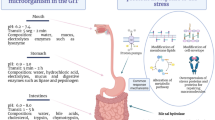Abstract
A coacervation method with double emulsion strategy (w/o/w) was used to prepare immobilized Lactobacillus E1. Diatomite was chosen as the carrier for bacteria. Sodium alginate, dextrin and gelatin were used as protective solutes for the preservation of Lactobacillus E1 and their effects on the storage viability during storage were discussed. The influence of storage temperature on the storage viability was also examined. The results show that high bacteria viable count over 109 cfu/g for an extended shelf life of 37 d can be achieved with 2% sodium alginate, 5% dextrin and 4% gelatin as protective solutes, at 10°C of the storage temperature. This immobilized Lactobacillus E1 has potential use as functional food ingredient for both human dairy food and animal feedstuff.
Similar content being viewed by others
References
A C Huggett, B Schliter. Research Needs for Establishing the Safety of Functional Foods[J]. Nutr. Rev., 1996, 54: 143–148
F Guarner, G J Schaafsma. Probiotics[J]. Int. J. Food Microbiol., 1998, 39: 237–238
R Fuller. Probiotics in Man and Animals[J]. J. Appl. Bacteriol., 1989, 66: 365–378
C Shortt. The Probiotic Century: Historical and Current Perspectives[J]. Trends Food Sci. Technol., 1999, 10: 411–417
A M P Gomes, X F Malcata. Bifidobacterium ssp. and Lactobacillus Acidophilus: Biological, Biochemical, Technological and Therapeutical Properties Relevant for Use as Probiotics[J]. Trends in Food Sci. Technol., 1999, 10: 139–157
N Ishibashi, S Shimamura. Bifidobacteria: Research and Development in Japan[J]. Food Technol., 1993, 46: 126–135
A Talwalkar, K Kailasapathy. A Review of Oxygen Toxicity in Probiotic Yogurts: Influence on the Survival of Probiotic Bacteria and Protective Techniques[J]. Compr. Rev. Food Sci. Food Saf., 2004, 3: 117–124
G A Birollo, J A Reinheimer, C G Vinderola. Viability of Lactic Acid Microflora in Different Types of Yoghurt[J]. Food Res. Int., 2000, 33: 799–805
K Kailasapathy, S Rybka. Acidophilus and Bifidobacterium spp.-their Theraputic Potential and Survival in Yoghurt[J]. Aust. J. Dairy Technol., 1997, 52: 28–34
R R Ravula, N P Shah. Viability of Probiotic Bacteria in Fermented Dairy Deserts[J]. Food Aust., 1998, 50: 136–139
C Stanton, G Gardiner, H Meehan, et al. Market Potential for Probiotics[J]. Am. J. Clin. Nutr., 2001, 73: 4 765–4 835
I N Haynes, M J Playne. Survival of Probiotic Cultures in Low Fat Ice-cream[J]. Aust. J. Dairy Technol., 2002, 57: 10–14
K Hanny, M Lorna. Process for Producing Extended Shelf-life Ready-to-use Milk Compositions Containing Probiotics[P]. US, A23C 9/123, WO 02/102168 A1. 27. 12. 2002
R S Porubcan, R L Sellars. Lactic Starter Culture Concentrates[M]. In: Peppler, H J, Perlman, D. Microbial Technology. New York: Academic Press, 1979(1): 59–92
K Adhikari, A Mustapha, I U Grün. Survival and Metabolic Activity of Microencapsulated Bifidobacterium Longum in Stirred Yogurt[J]. J. Food Sci., 2003, 68: 275–280
G Godward, K Kailasapathy. Viability and Survival of Free, Encapsulated and Co-encapsulated Probiotic Bacteria in Ice Cream[J]. Milchwissenschaft, 2003, 58: 161–164
C Amiet-Charpentier, J P Benoit, P Gadille, et al. Preparation of Rhizobacteria-containing Polymer Microparticles Using a Complex coacervation Method[J]. Colloids Surf., A: Physicochem. Eng. Aspects., 1998, 144: 179–190
V A E King, H J Lin, C F Liu. Accelerated Storage Testing of Freeze-dried and Controlled Low-temperature Vacuum Dehydrated Lactobacillus Acidophilus[J]. J. Gen. Microbiol., 1998, 44: 161–165
M Achour, N Mtimet, C Cornelius, et al. Application of the Accelerated Shelf Life Testing Method (ASLT) to Study the Survival Rates of Freeze-dried Lactococcus Starter Cultures[J]. J. Chem. Technol. Biotechnol., 2001, 76: 624–628
P Myll.arinen, P Forssell, A von Wright, et al. Starch Capsules Containing Microorganisms and/or Polypeptides or Proteins and a Process for Producing them[P]. FI, A61K 9/52, WO 99/52511 A1. 21.10.99
R S Porubcan, M N Victoria. Formulations to Increase in Vivo Survival of Probiotic Bacteria and Extend their Shelf-life[P]. US, A61K 39/00, US2004/0175389 A1. 9. 9. 2004
Author information
Authors and Affiliations
Corresponding author
Additional information
Funded by the National Natural Science Foundation of China (No. 30670566) and the ISTCP (No. 2006DFA33150)
Rights and permissions
About this article
Cite this article
Sun, X., Chen, X., Liu, C. et al. Influence of Lactobacillus E1 on the storage stability in emulsion immobilization. J. Wuhan Univ. Technol.-Mat. Sci. Edit. 24, 75–80 (2009). https://doi.org/10.1007/s11595-009-1075-y
Received:
Accepted:
Published:
Issue Date:
DOI: https://doi.org/10.1007/s11595-009-1075-y




